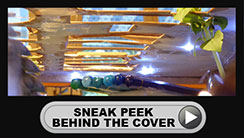
By Tara Lissner, Swiss Gardening School
There is a softening underfoot, a warmth in the air and dare I say that feeling of spring abounds! It’s true we’ve been fooled before; a lovely gentle week in February followed by lots of snow and a wind chill that felt like -16c. But it will come, that light in the day, that stretch in the evening and that warmth in the air that means below zero temperatures are just a memory.
I do so love the optimism of March. Every DIY catalogue that comes through the letter box is packed with the promise of spring with bunnies and daffodils in almost every picture; lawn mowers and garden tools to make every job a breeze. Furniture catalogues encourage us to enjoy outdoor living with new patio furniture, parasols, coffee tables and sofas, to plan dinners and parties with friends. We the gardeners know that this is all just a sales tactic for it is far too early to even begin thinking about outdoor living, we are all preoccupied with outdoor working; beds to dig, mulch to spread, plants to grow, shrubs to prune and seeds to sow.
Getting on top of planning the garden is all that I’ve been thinking about lately. I’ve manage to get through most of the early pruning dodging the raindrops and snowflakes but didn’t quite get to all the roses yet and now the rascals are starting to show signs of life which always makes it more difficult for me to wield the secateurs and loppers. I just need a sunny or rather not wet weekend to get that task over with.
Other jobs I’m considering at the moment are cleaning out my garden box in preparation for a busy season; planning out my vegetable garden; contemplating a cutting garden, planning some garden visits and for the quiet moments catching up on listening to gardening podcasts, reading gardening blogs and books. Where to start?
Unfortunately I don’t have a beautiful red brick garden shed à la Monty Don, with a peg for every tool and a great big work table for seed sowing and planting, I have a large rectangular white metal box (my garden shed) with a hinged lid (my work table) inherited from a friend who left my village for the US almost 17 years ago, and yes it is looking its age! Emptying out the box onto the terrace and cleaning off the tools, which were hurriedly thrown in as the snow fell a few weeks ago, is first on my list. All sorts of treasures usually resurface following this spring clean. I’ve been know to find the lost spring from my secateurs, my favourite ball of twine, the dogs favourite ball and even a mug. I take out the tools, lay them on a tarp and have a good look at them. Some can be retired to the garage, like the pick axe which is not an every day kind of tool and others like the great selection of hand trowels and hand forks I have accumulated need to be cleaned and just gathered together so that I can put my hand on one when I need it. That said it helps when I remember to put them back where they came from – but that, as they say, is a story for another day. I give (almost) everything a quick scrub with a brush and warm soapy water, when dry I sharpen the spades and hoes with an all-purpose file, sharpening at a 45 degree angle running the file a couple of times across the blade – it makes a tremendous difference. With a rag I wipe the wooden handles of the tools with linseed oil, this nourishes the wood and helps prevent splitting, especially if the tools spend an unexpected night or two out in the rain! Secateurs should be taken apart, oiled, sharpened and always kept indoors! If you own a Felco you can always bring it along to a Felco stand at the many Swiss garden markets throughout the season and they will do it for you for free.
Next on my list is the vegetable garden. I think it is so important to be realistic when planning a vegetable garden. The most important question that needs to be address before you start is are you going to be at home this summer? There really is little point to putting in a lot of early work into a vegetable garden if you are not going to be here to enjoy the fruits of your labour. This is not to say don’t grow anything it just is to say consider when your crop will harvest. Take courgettes for example, they are super easy to grow here even from seed, and almost always produce a great crop but you have to be around to pick them when they are ready; the more you pick the more fruit you encourage to grow. However, if you are away you will return to find up to about half a dozen huge marrows per plant that nobody wants to eat. Think early crops and think late crops, don’t forget that the growing season may well continue into early October.
If seed sowing is too much for you or you just don’t have the space or indeed the time to do it consider ordering plant plugs for your vegetable garden. The wonderful organic farm in Petit Saconnex La Ferme de Budé organizes the sale of organic plant plugs grown locally in Geneva in the greenhouses of the association les artichaux. You can see their on-line catalogue, complete with photos (link above), and order on-line until Sunday 19 March for pick-up at their market shop on Friday 4 and Saturday 5 May.
I’ve always wanted a cutting garden. I do so love to pick flowers and have them in the house or in little vases on the dinner table mixed with herbs. I don’t like to feel that I’m taking the final or only bloom on a plant or decimating one because I want 10 stems to fill a vase; the only way around that is to dedicate some space to a cutting garden. I’m only in the planning stage now so I’ll let you know how I get on and what I decide to plant.
Other jobs to think about now are pruning, feeding and mulching. Prune the stems from cornus, either coppicing down to the ground or removing one third of all stems, new growth will be vibrant in colour, yellow, orange, green or red and will look great next winter. Prune wisteria back to 2 or 3 bud on the side shoots for a good show this summer. Cut back ornamental grasses before signs of new growth to within a few centimeters of the soil. Prepare the vegetables beds by removing any weeds and forking in compost in preparation for planting. If you planted a green crop for winter cover it is time to dig it into the bed to allow it to rot down completely before new planting. Keep on top of the weeds whenever you see them by pulling them now before they become established. Roses should have all crossing or damaged branches removed, remembering to create a goblet shaped plant when you prune, this encourages good air movement which decreases the chances of disease. Once the ground is soft enough, plant new bare-rooted roses, they are less expensive than the potted versions. Finally autumn fruiting raspberries should be trimmed to the level of the soil, encouraging new growth which will bear fruit this summer – yum!
Author's bio

An enthusiastic, self-taught gardener, Tara Lissner is passionate about gardening and eager to share her zeal and knowledge with other gardening fans.
In 2012, she joined forces with Hester Macdonald, a British-trained landscape designer, to launch the Swiss Gardening School.
(Photo by Jean-Luc Pasquier)
Swiss Gardening School
www.swissgardeningschool.com









